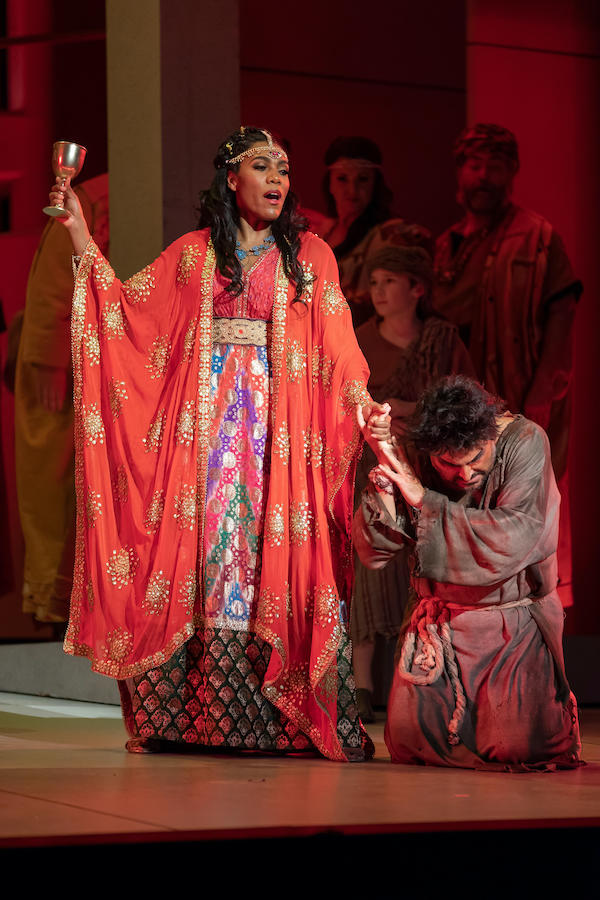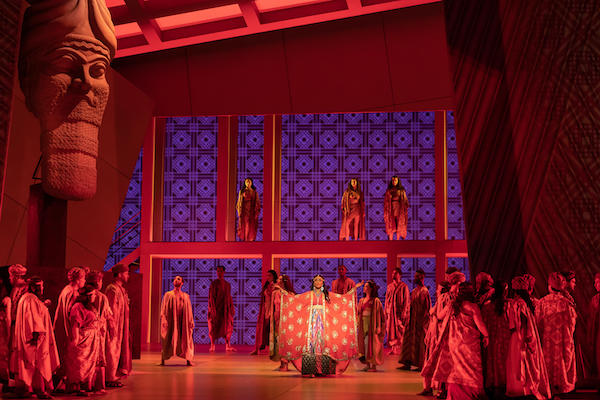Bridges’ blazing WNO debut leads an excellent cast and vibrant production in “Samson et Dalila”

The sexual deceiver in Samson et Dalila is a woman. This makes it an interesting counterpart to Don Giovanni, with which it is running in repertory at Washington National Opera this month (and sharing the same unit set). Camille Saint-Saëns’ heavily perfumed Biblical opera opened Sunday afternoon in the Kennedy Center Opera House and featured a slew of outstanding company debuts.
Drawn from the final episode in the Book of Judges, the libretto by Ferdinand Lemaire relates the fall of Samson. With superhuman powers bestowed by God on account of his vows, Samson leads a rebellion against the Philistines. He falls in love with a Philistine woman, Dalila, who uses her seductive hold on him to learn the secret source of his strength. She cuts his hair and turns him over to the Philistines, who put out his eyes. God restores Samson’s strength before his death, and he brings down the roof of the Temple of Dagon on all their heads.
Based on hearing mezzo-soprano J’Nai Bridges when she was in the young singers program at Wolf Trap Opera Company, her WNO bow seemed a natural next step. It has finally happened, and this was the sort of blazingly successful debut that heralds a major star. Bridges, who also made her Metropolitan Opera debut this season, sang the role of the Philistine temptress with astounding technique, from a molasses-rich chest voice up to puissant heights.
Many vocal colors came to the fore in different scenes, beginning with a corrosive venom in “Amour! viens aider ma faiblesse” and continuing with a silken legato line in “Printemps qui commence.” Costumed in sumptuous, multi-colored gowns, Bridges also moved seductively, even taking part in the alluring ballet scenes featuring a group of WNO Dancers (suggestive choreography by Eric Sean Fogel).
Roman tenor Roberto Aronica made a debut just slightly less striking as Samson. His rough-hewn tone, with plenty of power if sometimes lacking in finesse, suited the inflexible judge-hero. Vocal force is what makes the role believable, and Aronica had more than enough of that to lend credence to the character’s feats of strength.
The list of noteworthy debuts continued with baritone Noel Bouley, whose raging snarl in the top notes made his High Priest of Dagon poisonous and spiteful. In his incestuous scene with Bridges’ Dalila, he matched her in vocal sheen and malice. As the short-lived Abimélech, bass-baritone Tómas Tómasson, another of the cast’s WNO debuts, displayed the best French pronunciation as well as a glossy, polished tone.
Peter Volpe, heard Saturday night as the Commendatore in Don Giovanni, showed more of the deep bass side of his vocal range as the Old Hebrew. His big scene advising Samson was a highlight of sensitive musicality. Current members of WNO’s Domingo-Cafritz Young Artist Program acquitted themselves admirably in the comprimario roles: tenor Matthew Pearce and bass-baritone Samuel J. Weiser as the First and Second Philistines, respectively, and tenor Joshua Blue as the Messenger.
The WNO Chorus had much more to sink its teeth into in this opera, which features extensive choral scenes. On and off stage, they sounded unified, balanced, and capable of both shattering fortes and pianissimo warmth. Much of their success was predicated on the sure guiding hand of American conductor John Fiore, in another noteworthy WNO debut. Whenever the chorus or an individual singer seemed to go astray, Fiore’s left hand signaled with absolute clarity where they should be.
Likewise, under Fiore’s leadership, the WNO Orchestra sounded in optimal shape, all players in lockstep. The woodwind section especially slinked and shimmied with exotic color in this panting and gasping score. The ballet scenes, especially the sacrificial dance before the idol of Dagon in Act II, were not only not aptly cringeworthy but transporting. Saint-Saëns does go overboard in the orchestration, especially in that extended section accompanied by glockenspiel in the final scene.
Director Peter Kazaras had the same basic canvas to work with as the director of Don Giovanni, in the sets of Erhard Rom. The tilted walls and skylight-filled ceiling, crossing at angles, hardly looked the same here, splashed with deep purples, blues, and reds (lighting by Robert Wierzel). In particular the video projections (designed by S. Katy Tucker) gave a vivid impression of the Holy Land, with sultry moons, flashing lightning, and a blazing sun.
The idol of Dagon, based on the head of a lamassu, did not fall completely over, but the apocalyptic video flames left no doubt of the final cataclysm. Michael Scott designed many of the costumes for WNO’s last production of this opera, back in 2005, but additional costumes designed by Timm Burrow lessened the previous sense of a cheesy Biblical epic by Cecil B. DeMille. The visual splendor eased the dramatic inertia of this opera, conceived first as an oratorio, creating a feast for both eyes and ears.
Samson et Dalila runs through March 21. kennedy-center.org; 202-467-4600

